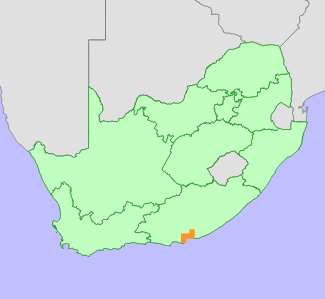|
Scientific Name | Argyrolobium barbatum Walp. |
Higher Classification | Dicotyledons |
Family | FABACEAE |
Synonyms | Chasmone barbata Meisn. |
National Status |
Status and Criteria | Vulnerable A2c |
Assessment Date | 2006/05/19 |
Assessor(s) | T.J. Edwards & D. Raimondo |
Justification | There are six known locations, two of which have been lost to urban and industrial development and a large proportion of the subpopulation at another location at Coega Kop declined within the past 100 years. This decline is estimated to represent a 30% reduction in the population over two generations - this is a long-lived resprouter and generation length is suspected to be at least 50 years. |
Distribution |
Endemism | South African endemic |
Provincial distribution | Eastern Cape |
Range | Paterson and Addo to Port Elizabeth. |
Habitat and Ecology |
Major system | Terrestrial |
Major habitats | Sundays Valley Thicket, Nanaga Savanna Thicket |
Description | Bushveld, limestone outcrops. |
Threats |
| Pollution (affecting habitat and/or species), Invasive Alien Species (direct effects), Habitat loss, Habitat degradation |
Population |
Population trend | Stable |
Assessment History |
Taxon assessed |
Status and Criteria |
Citation/Red List version | | Argyrolobium barbatum Walp. | VU A2c | Raimondo et al. (2009) | | Argyrolobium barbatum Walp. | Indeterminate | Hilton-Taylor (1996) | |
Bibliography |
Edwards, T.J. 2005. A synopsis of Argyrolobium (tribe Genisteae, Papilionoideae) in South Africa. South African Journal of Botany 71(3):380-417.
Hilton-Taylor, C. 1996. Red data list of southern African plants. Strelitzia 4. South African National Botanical Institute, Pretoria.
Raimondo, D., von Staden, L., Foden, W., Victor, J.E., Helme, N.A., Turner, R.C., Kamundi, D.A. and Manyama, P.A. 2009. Red List of South African Plants. Strelitzia 25. South African National Biodiversity Institute, Pretoria.
|
Citation |
| Edwards, T.J. & Raimondo, D. 2006. Argyrolobium barbatum Walp. National Assessment: Red List of South African Plants version 2024.1. Accessed on 2025/10/26 |
 Comment on this assessment
Comment on this assessment


